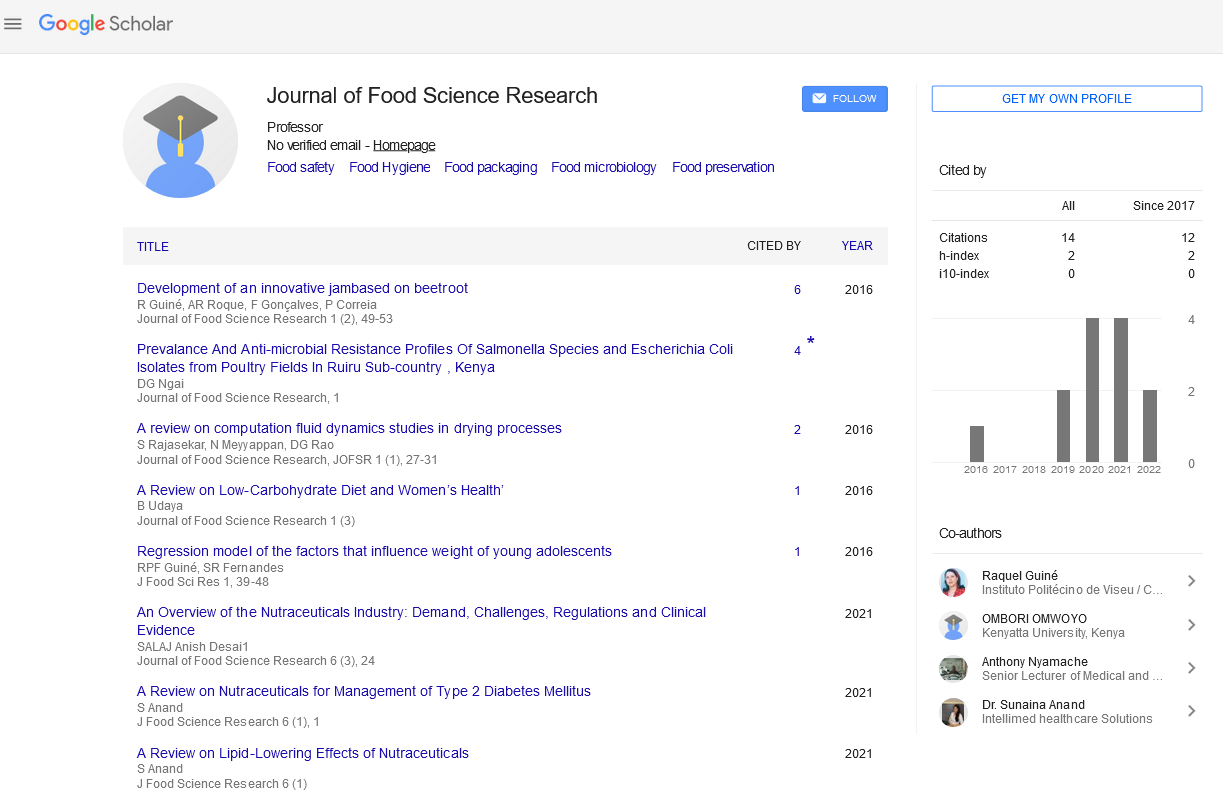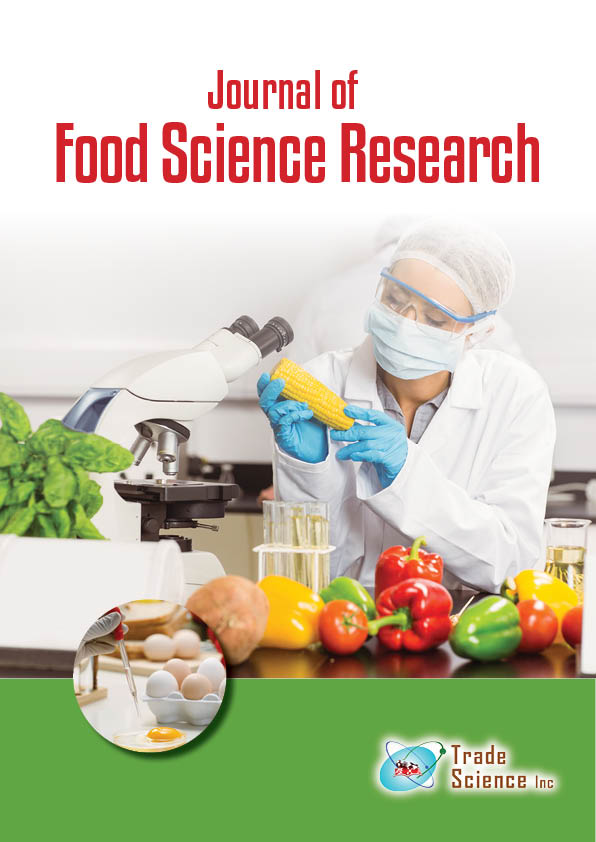Current opinion
, Volume: 7( 1) DOI: 10.37532/ J Food Sci Res.2022.07.94Human Milk Microbiota and Oligosaccharides and Fatty Acids Analyses in the Child Cohort
Mouhid Lamia*
Department of Nutrition, University of Granada, Granada, Spain
*Corresponding Author:Mouhid Lamia
Department of Nutrition, University of Granada, Granada, Spain
Email: mouhidlamia6@gmail.com
Received date: February 01, 2022, Manuscript No. TSFSR-21-59728; Editor assigned date: February 03, 2022, PreQC No. TSFSR-21-59728(PQ)); Reviewed date: February 14, 2022, QC No. TSFSR-21-59728; Revised date: February 25, 2022, Manuscript No: TSFSR-21-59728(R); Published date: March 04, 2022, DOI: 10.37532/ J Food Sci Res.2022.07.94.
Citation: Lamia M. Human Milk Microbiota and Oligosaccharides and Fatty Acids Analyses in The Child Cohort. J Food Sci Res. 7(1):94 © 2022 Trade Science Inc.
Abstract
Introduction
Overweight and obesity rates in children have risen considerably over the last three decades and remain high, with a prevalence of approximately 23% in children aged 2 year-5year. Obesity and its health implications are difficult to manage once established, and they frequently remain throughout adulthood. To aid in the development of early interventions, it is vital to identify characteristics in early infancy that increase or lessen the risk of excessive weight growth and obesity. Breastfeeding has been found in numerous studies to reduce the risk of obesity in children and adolescents. However, not all research back up this claim, and a systematic evaluation of 71 publications indicated only a minor protective effect of breastfeeding on obesity prevention, with breastfeeding lowering the prevalence of overweight and obesity by 10%. These contradictory results could be due in part to the diverse composition of human breast milk, which contains macronutrients, micronutrients, and a slew of other bioactive compounds (cytokines, adipokines, chemokines and cofactors) that are only now being discovered and studied, and that differ between women and over time. Human milk contains significant levels of unconjugated glycans, complex sugars known as Human Milk Oligosaccharides (HMOs), which are not found in infant formula at the moment. Lactose is carried at the reducing end of HMOs, which can be extended by galactose disaccharides and N-acetyl glucosamine, and modified by fructose and/or Salic acid. So date, more than 150 structurally unique HMOs have been discovered, with many of their biological effects being structure specific. HMOs are resistant to breakdown in the small intestine and survive in the colon, where they serve as particular metabolic substrates for specific bacteria and help build the baby gut micro biome. HMOs and their fucosylated components, for example, promote the growth of bifid bacteria, which dominate the micro biota of breastfed babies. Because HMOs alter epithelial cell responses in the stomach, they are absorbed and enter the circulation, where they may exert systemic effects; they may have a more direct effect on new-born growth and body composition. Because HMO composition varies between women and over the course of lactation, we hypothesized that differences in HMO composition in mother?s milk are associated with infant growth and body composition. To test this hypothesis, we examined a cohort of 25 mother-infant pairs at 1-mo and 6-mo postpartum and analysed relations between HMO composition and infant growth and body composition.
Breast-Milk Collection and HMO Analysis
Again for analyses of breast milk disclosed earlier by our research, mothers were advised to pump the complete contents of a single breast expressing. HMO analysis was carried out by HPLC after fluorescence derivatization at the Uni- versity of California, San Diego, as previously described. To ensure absolute measurement, raff nose was added to each milk sample. The sum of the particular oligosaccharides found was used to compute the HMO total concentration. On the basis of retention time comparisons with commercial standard oligosaccharides and mass spectrometry analysis, the following 16 HMOs were identified: 2?-FL, 3?-FL, 3?-sialyllactose, Lacto-N-Tetraose (LNT), Lacto-N-Neotetraose (LNnT), Lacto-N-Fucopentaose (LNFP) I, LNFPII, LNFPIII, sialyl-LNT (LST) b, LSTc, difucosyl- The presence of 2?-FL or LNFP was used to determine secretor status.The reciprocal sum of the square of the relative abundance of each of the measured HMOs was used to generate simpson?s Diversity index (D).
Human Milk Oligosaccharides
This is the only study that we are aware of that looks at HMO variation and how it affects new-born growth and obesity during early development. Growing data suggests that non-nutritive chemicals in human breast milk have an early impact on growth and body composition. Our major goal was to see if HMOs were linked to infant growth and body composition at 1 and 6 months of age in a cohort of 25 breastfeeding mother-infant couples. Emerging evidence also suggests that elevated lepton and insulin in breast milk may influence new-born body weight, albeit the evidence isn?t conclusive. Based on this research, our findings imply that HMOs are linked to new-born body weight, fat mass, and lean mass at both 1 month and 6 months. LNFPI was one of the most well-known HMO-infant body composition relationships, with 1-mo LNFPI being inversely related to 1-mo new-born weight and 6-mo LNFPI being inversely related to infant weight, lean mass, and fat mass. According to the findings, a 1-SD rise in LNFPI was related with a 677-g lower weight, 519-g lower lean mass, and 482-g lower fat mass after 6 months. Importantly, the 1 month and 6 month LNFPI explained 18% and 6% greater variance in child weight at each time point than other relevant factors including maternal pre-pregnancy BMI and pregnancy weight increase, respectively. Certain HMOs, such as LNFPI, exhibit greater connections between mother?s milk and new-born plasma than urine, according to a recent research of ten mother-infant couples. These data could imply selective intestine or systemic use of LNFPI, as stated by the authors, which could explain part of our findings. Given that the presence of these HMOs in infant stool substantially altered during early life, with LNFPII increasing while LNFPI declined over 13 weeks, the contradictory relationships between LNFPI and LNFPII with child body composition were fascinating. HMOs are hypothesized to promote the developing baby micro biome?s development and metabolic efficiency. Measures of diversity and evenness have traditionally been employed to characterize the micro biome, where diversity refers to the variety of bacterial species present, and evenness refers to the relative fraction of each species present. This is the first study that we are aware of that looks at HMO variety and evenness in relation to baby growth and body composition. We found strong inverse relationships between 1-mo HMO diversity and evenness and 1-mo adiposity measurements, with a 1-SD increase in either diversity or evenness associated with a 6.3% lower fat mass. Simultaneously, we discovered that HMO diversity and evenness accounted between 17% and 20% greater variance in adiposity than other key predictors including maternal BMI before pregnancy and pregnancy weight gain. Although we did not collect stool samples, preliminary findings suggest that the prebiotic effects of HMOs may play a role in the current investigation. A recent study indicated that breastfed infants had a different fiscal micro biota composition than formula-fed infants, and that the fiscal micro biota in breastfed infants corresponded with the HMOs eaten (particularly LNFPI and DSLNT). Another adult study discovered a link between gut microbial richness and obesity and metabolic markers, bolstering the theory that variations in breast-milk composition may modulate gut flora, alter gastrointestinal activities, and influence inflammatory processes, affecting infant growth and body composection. Future research will need to prove if HMO diversity and evenness are linked to micro biome diversity and even- ness, and if these relationships have a role in early baby body composition. Our findings do not provide convincing proof of independent effects of HMOs on baby growth and body composition due to the limited sample size used in this investigation. We infer that the total composition of HMOs in breast milk appears to be connected to infant growthand body composition because the current data did not tolerate several correction tests. To determine the precise impact of individual HMOs to new-born development, future research should be conducted in bigger samples with longer follow-up. We are unable to make definitive conclusions on the relationships between HMOs and baby outcomes since data was only collected at ages 1 and 6 months. Because HMOs are absorbed and reach the circulation, they may have direct effects on baby growth and body composition through effects on epithelial cell responses in the stomach or through systemic effects. HMOs, for example, may have an impact on brain development, which is crucial for controlling baby feeding behavior. It?s also likely that HMOs are linked to new born growth and body composition because of natural fluctuations throughout time. Because we were unable to investigate whether these relationships differed by obesity status or race-ethnicity, the generalizability of our findings is limited. Additionally, more research is required to properly comprehend the molecular linkages between HMOs and new-born development, as well as the role of the infant gut micro biome and metabolite.Finally, because our definition of nursing only included the use of infant formulae, solid food introduction in some infants may have happened, contributing to growth and body composition. Despite these limitations, the findings of this study suggest that the composition and diversity of HMOs contained in breast milk may influence infant growth and body composition.

